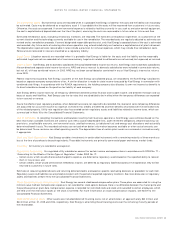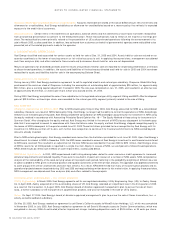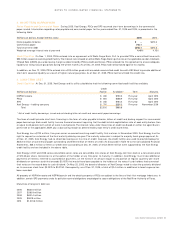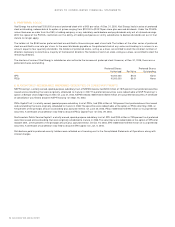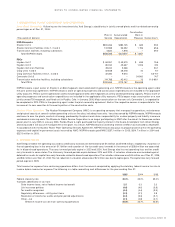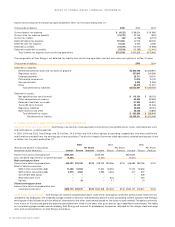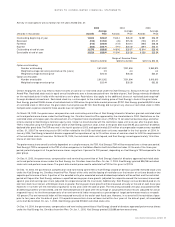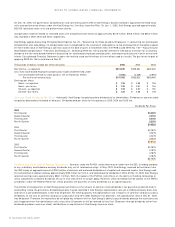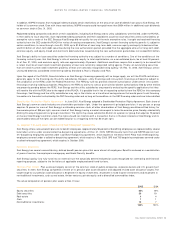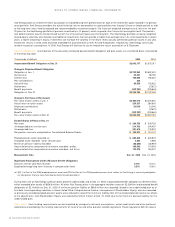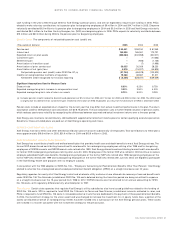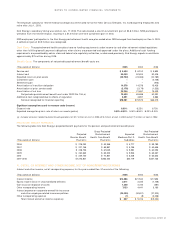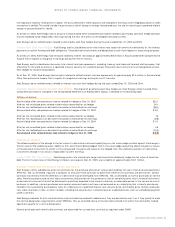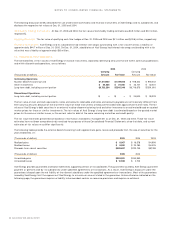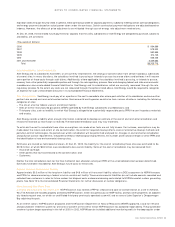Xcel Energy 2005 Annual Report Download - page 61
Download and view the complete annual report
Please find page 61 of the 2005 Xcel Energy annual report below. You can navigate through the pages in the report by either clicking on the pages listed below, or by using the keyword search tool below to find specific information within the annual report.
In addition, NSP-Minnesota’s first mortgage indenture places certain restrictions on the amount of cash dividends it can pay to Xcel Energy, the
holder of its common stock. Even with these restrictions, NSP-Minnesota could have paid more than $854 million in additional cash dividends
on common stock at Dec. 31, 2005.
Registered holding companies and certain of their subsidiaries, including Xcel Energy and its utility subsidiaries, were limited, under the PUHCA,
in their ability to issue securities. Such registered holding companies and their subsidiaries could not issue securities unless authorized by an
exemptive rule or order of the SEC. Because Xcel Energy did not qualify for any of the main exemptive rules, it sought and received financing
authority from the SEC under the PUHCA for various financing arrangements. Xcel Energy’s current financing authority permits it, subject to
certain conditions, to issue through June 30, 2008, up to $1.8 billion of new long-term debt, common equity and equity-linked securities
and $1.0 billion of short-term debt securities during the new authorization period, provided that the aggregate amount of long-term debt,
common equity, and equity-linked and short-term debt securities issued during the new authorization period does not exceed $2.0 billion.
Xcel Energy’s ability to issue securities under the financing authority was subject to a number of conditions. One of the conditions of the
financing authority was that Xcel Energy’s ratio of common equity to total capitalization, on a consolidated basis, be at least 30 percent.
As of Dec. 31, 2005, such common equity ratio was approximately 42 percent. Additional conditions require that a security to be issued that
is rated, must be at least rated investment grade by at least one nationally recognized rating agency. Finally, all outstanding securities
that are rated must be rated investment grade by at least one nationally recognized rating agency. On Feb. 10, 2006, Xcel Energy’s senior
unsecured debt was considered investment grade by Standard & Poor’s, Moody’s and Fitch.
Upon the repeal of the PUHCA, these limitations on Xcel Energy’s financings generally will no longer apply, nor will the PUHCA restrictions
generally apply to the financings by the utility subsidiaries. However, utility financings and intra-system financings will become subject to
the jurisdiction of the FERC under the Federal Power Act. The FERC by rule has granted a blanket authorization under certain intra-system
financings involving holding companies. Requests to the FERC to clarify its rules or grant similar blanket authorizations filed by other entities
are presently pending before the FERC. Xcel Energy and the utility subsidiaries are presently evaluating the specific applications that they
will need to file with the FERC due to the repeal of the PUHCA. It is possible that in lieu of requesting authority from the FERC for intra-company
financings, Xcel Energy and the utility subsidiaries may rely in the interim on a transitional savings clause that would permit such financing
transactions to the extent authorized by the SEC financing order and so long as the conditions in the SEC financing order continue to be satisfied.
Stockholder Protection Rights Agreement
In June 2001, Xcel Energy adopted a Stockholder Protection Rights Agreement. Each share of
Xcel Energy’s common stock includes one shareholder protection right. Under the agreement’s principal provision, if any person or group
acquires 15 percent or more of Xcel Energy’s outstanding common stock, all other shareholders of Xcel Energy would be entitled to buy, for
the exercise price of $95 per right, common stock of Xcel Energy having a market value equal to twice the exercise price, thereby substantially
diluting the acquiring person’s or group’s investment. The rights may cause substantial dilution to a person or group that acquires 15 percent
or more of Xcel Energy’s common stock. The rights should not interfere with a transaction that is in the best interests of Xcel Energy and its
shareholders because the rights can be redeemed prior to a triggering event for $0.01 per right.
10. BENEFIT PLANS AND OTHER POSTRETIREMENT BENEFITS
Xcel Energy offers various benefit plans to its benefit employees. Approximately 56 percent of benefiting employees are represented by several
local labor unions under several collective-bargaining agreements. At Dec. 31, 2005, NSP-Minnesota had 2,144 and NSP-Wisconsin had
417 bargaining employees covered under a collective-bargaining agreement, which expires at the end of 2007. PSCo had 2,165 bargaining
employees covered under a collective-bargaining agreement, which expires in May 2006. SPS had 733 bargaining employees covered under
a collective-bargaining agreement, which expires in October 2008.
PENSION BENEFITS
Xcel Energy has several noncontributory, defined benefit pension plans that cover almost all employees. Benefits are based on a combination
of years of service, the employee’s average pay and Social Security benefits.
Xcel Energy’s policy is to fully fund into an external trust the actuarially determined pension costs recognized for ratemaking and financial
reporting purposes, subject to the limitations of applicable employee benefit and tax laws.
Pension Plan Assets
Plan assets principally consist of the common stock of public companies, corporate bonds and U.S. government
securities. In 2004, Xcel Energy completed a review of its pension plan asset allocation and adopted revised asset allocation targets. The
target range for our pension asset allocation is 60 percent in equity investments, 20 percent in fixed income investments and 20 percent in
nontraditional investments, such as real estate, timber ventures, private equity and a diversified commodities index.
The actual composition of pension plan assets at Dec. 31 was:
2005 2004
Equity securities 65% 69%
Debt securities 20 19
Real estate 44
Cash 11
Nontraditional investments 10 7
100% 100%
XCEL ENERGY 2005 ANNUAL REPORT 59
NOTES TO CONSOLIDATED FINANCIAL STATEMENTS


